
The Ultimate Munich and Prague Itinerary in 8 Days
 8 Day Tour of Munich and Prague
8 Day Tour of Munich and Prague
Overview
Trip Map
Itinerary
Inclusions
Reviews







8 Days 7 Nights
Best Time: Jan-Dec
Cultural Exploration
History Buffs
On this journey through Munich and Prague you'll enjoy grand splendor and sophisticated culture in two of Central Europe's most vibrant cities. In Munich, wander the cobblestone lanes of the Altstadt and explore the vast Deutsches Museum, before journeying to the Alpine foothills to see the fantastic Neuschwanstein Castle. Then take a direct train to Prague, where you'll find a visual feast of history and beauty. Cross the Charles Bridge, take a peak at the Lennon Wall, and soak in the view from Prague Castle. With a private guided tour in each city and detailed travel guidance included, your trip will be both truly immersive and stress-free.
- Witness the Glockenspiel's enchanting performance on the Marienplatz beneath the neo-Gothic townhall
- Explore the gilded halls of Munich's Residence Palace, former home of Bavarian royalty
- Journey to Karlštejn Castle by train, a fairy-tale fortress guarding the king's treasure
- Immerse yourself in the enchanting Baroque atmosphere of Prague's Little Quarter
- Enjoy the hearty cuisine and world-renowned brews of two of the world's most famous beer cities
On this journey through Munich and Prague you'll enjoy grand splendor and sophisticated culture in two of Central Europe's most vibrant cities. In Munich, wander the cobblestone lanes of the Altstadt and explore the vast Deutsches Museum, before journeying to the Alpine foothills to see the fantastic Neuschwanstein Castle. Then take a direct train to Prague, where you'll find a visual feast of history and beauty. Cross the Charles Bridge, take a peak at the Lennon Wall, and soak in the view from Prague Castle. With a private guided tour in each city and detailed travel guidance included, your trip will be both truly immersive and stress-free.
- Witness the Glockenspiel's enchanting performance on the Marienplatz beneath the neo-Gothic townhall
- Explore the gilded halls of Munich's Residence Palace, former home of Bavarian royalty
- Journey to Karlštejn Castle by train, a fairy-tale fortress guarding the king's treasure
- Immerse yourself in the enchanting Baroque atmosphere of Prague's Little Quarter
- Enjoy the hearty cuisine and world-renowned brews of two of the world's most famous beer cities

Old Town
Architecture

Residence Palace
Castles & Chateaux

Deutsches Museum
Museums & Galleries

Prague Castle
Castles & Chateaux

Charles Bridge
Historic Landmarks

Wenceslas Square
European History
Must see sights

Old Town
Architecture

Residence Palace
Castles & Chateaux

Deutsches Museum
Museums & Galleries

Prague Castle
Castles & Chateaux

Charles Bridge
Historic Landmarks

Wenceslas Square
European History
Starting from
$1499
per person
 Not included
Not included Secure Your Customizable Trip
Enter your details to embark on a journey that can be tailored just for you.
Start
Travelers
0 travelers
Add Room
Remove Room
Preferred Hotel Stars
Select Hotel Stars
Craft Your Own Itinerary
Select your interests and destinations for a trip plan inspired by you.
Trip Map & Itinerary
Enable/Disable Map Scrolling
Click To Make Map Interactive

Trip Timeline
 Edit Details
Edit DetailsArrival
3 nights
Munich
Germany
Train: 6h
4 nights
Prague
Czech Republic
Departure
Day-By-Day Itinerary
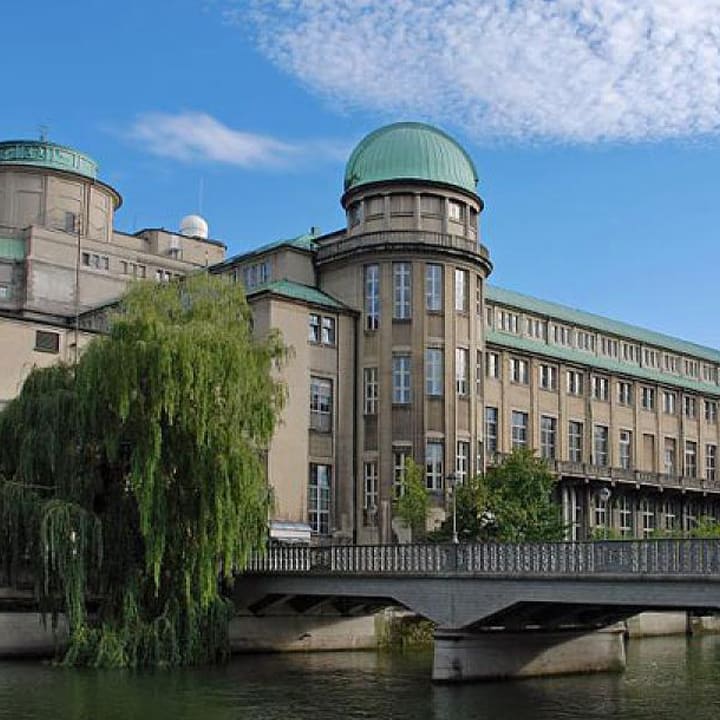
Day 1
Arrive Munich
View More
Day 1
Arrive Munich



To Be Determined
Arrival in Munich Airport and Transfer by Taxi or Train
Munich has one main airport, Munich International Airport, where almost all visitors arrive. Taxis are available directly at the terminal exit, or you can arrange a private transfer for added convenience. The cheapest and fastest way to reach central Munich from is by train. The regional "S-bahn" trains delivers you from the airport train station (just follow the signs) directly to Munich's main station (München hbf) in the center of the city, from where you can easily hail a taxi that will be much less expensive than from the airport.

Day 1
Arrive Munich
View More


Day 1
Arrive Munich




To Be Determined:
Transfer from Airport
Mid-Day/Afternoon:
Deutsches Museum
Late Afternoon/Early Evening:
Residence Palace


Day 2
Munich
View More
Day 2
Munich



9:00 AM - 11:30 AM
Guided Walk Tour of Historic Munich
Munich contains many reminders of a long and varied history but also encompasses the modern features of a strong and vibrant city. The insights of a local help make sense of the traditions, trends, and promises of Bavaria's Capital - sometimes referred to as the city of laptops and lederhosen. On this tour, your guide will show you the highlights of Munich and point out the many hidden treasures.

Day 2
Munich
View More


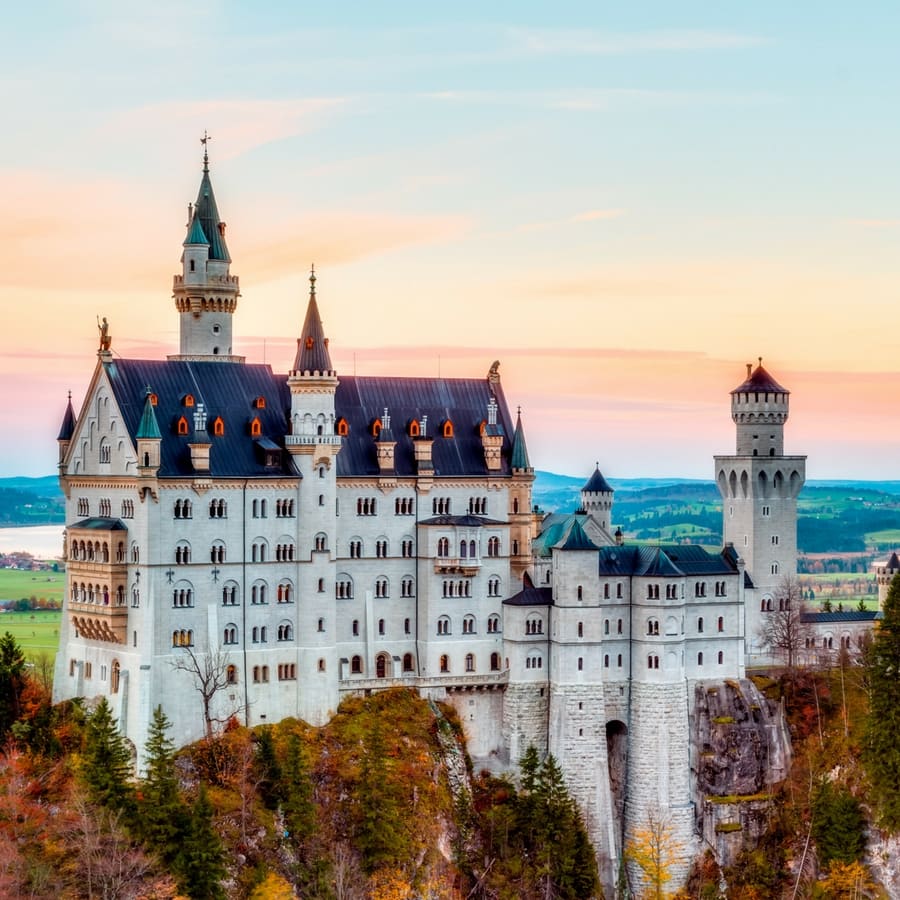
Day 3
Munich
View More
Day 3
Munich


Early Morning to Early Evening
Self Guided Excursion to Neuschwanstein Castle
An inspiration for the Disney Castles, numerous fairy tales, and countless dreamers, the Castle of Neuschwanstein is perhaps the most famous castle in the world. The eccentric Bavarian King Ludwig II created this amazing palace in the 19th century as an idyllic version of a medieval castle. You can visit by taking a guided tour from Munich or traveling independently by train and bus. In addition to enjoying spectacular views you can take a guided tour of the castle interior which is well worth the experience (but keep in mind that there a lots of steps to negotiate). If traveling independentally, be sure to book your interior tour reservations at least two days in advance.

Linderhof Palace
Stop by King Ludwig II's smallest palace on your way to Neuschwanstein and explore its delightful gardens.
Show More

Mary's Bridge
Enjoy a stunning view of the castle while suspended over a mountainous gorge.
Show More

Linderhof Palace
Stop by King Ludwig II's smallest palace on your way to Neuschwanstein and explore its delightful gardens.
Show More

Mary's Bridge
Enjoy a stunning view of the castle while suspended over a mountainous gorge.
Show More

Linderhof Palace
Stop by King Ludwig II's smallest palace on your way to Neuschwanstein and explore its delightful gardens.
Show More

Mary's Bridge
Enjoy a stunning view of the castle while suspended over a mountainous gorge.
Show More
prev
next

Day 3
Munich
View More


Linderhof Palace
 Highlight of Excursion to Neuschwanstein Castle
Highlight of Excursion to Neuschwanstein CastleStop by King Ludwig II's smallest palace on your way to Neuschwanstein and explore its delightful gardens.
Another of the eccentric (some say mad) King Ludwig II's creations is Linderhof Palace, which with its fantastic grotto and Moorish pavilion testifies to the king's vision. The smallest of his three palaces that he built, it is the only one that he lived to see completed. The palace is in between Munich and Neuschwanstein, meaning many tours stop there along the way.
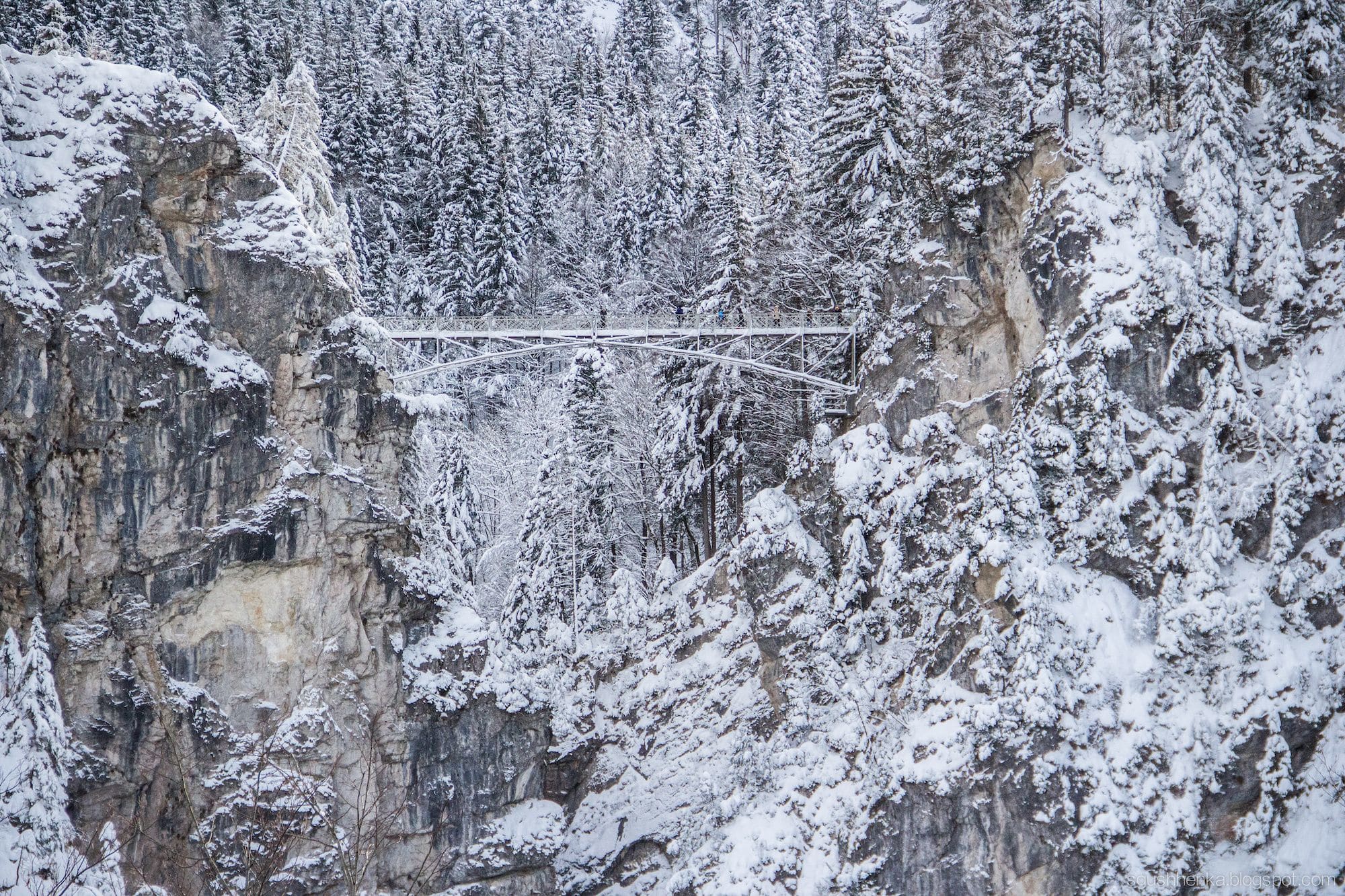
Mary's Bridge
 Highlight of Excursion to Neuschwanstein Castle
Highlight of Excursion to Neuschwanstein CastleEnjoy a stunning view of the castle while suspended over a mountainous gorge.
You definitely won't want to miss taking in the best views and photographs of Neuschwanstein from Marienbrücke (Mary's Bridge) over the dramatic Pöllat Gorge. The minibus terminal is very close at just 5 min walk away, while it's a steepish 10-15min climb on a wide and well-groomed path to get there from behind the castle. As noted above, Mary's Bridge can get a little crowded, so you might have to wait for a gap before you can fit on.

Linderhof Palace
 Highlight of Excursion to Neuschwanstein Castle
Highlight of Excursion to Neuschwanstein CastleStop by King Ludwig II's smallest palace on your way to Neuschwanstein and explore its delightful gardens.
Another of the eccentric (some say mad) King Ludwig II's creations is Linderhof Palace, which with its fantastic grotto and Moorish pavilion testifies to the king's vision. The smallest of his three palaces that he built, it is the only one that he lived to see completed. The palace is in between Munich and Neuschwanstein, meaning many tours stop there along the way.

Mary's Bridge
 Highlight of Excursion to Neuschwanstein Castle
Highlight of Excursion to Neuschwanstein CastleEnjoy a stunning view of the castle while suspended over a mountainous gorge.
You definitely won't want to miss taking in the best views and photographs of Neuschwanstein from Marienbrücke (Mary's Bridge) over the dramatic Pöllat Gorge. The minibus terminal is very close at just 5 min walk away, while it's a steepish 10-15min climb on a wide and well-groomed path to get there from behind the castle. As noted above, Mary's Bridge can get a little crowded, so you might have to wait for a gap before you can fit on.

Linderhof Palace
 Highlight of Excursion to Neuschwanstein Castle
Highlight of Excursion to Neuschwanstein CastleStop by King Ludwig II's smallest palace on your way to Neuschwanstein and explore its delightful gardens.
Another of the eccentric (some say mad) King Ludwig II's creations is Linderhof Palace, which with its fantastic grotto and Moorish pavilion testifies to the king's vision. The smallest of his three palaces that he built, it is the only one that he lived to see completed. The palace is in between Munich and Neuschwanstein, meaning many tours stop there along the way.

Mary's Bridge
 Highlight of Excursion to Neuschwanstein Castle
Highlight of Excursion to Neuschwanstein CastleEnjoy a stunning view of the castle while suspended over a mountainous gorge.
You definitely won't want to miss taking in the best views and photographs of Neuschwanstein from Marienbrücke (Mary's Bridge) over the dramatic Pöllat Gorge. The minibus terminal is very close at just 5 min walk away, while it's a steepish 10-15min climb on a wide and well-groomed path to get there from behind the castle. As noted above, Mary's Bridge can get a little crowded, so you might have to wait for a gap before you can fit on.
prev
next

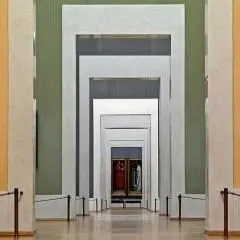
Day 4
Munich to Prague
View More
Day 4
Munich to Prague





Morning/Mid-Day
Touring the Museums of Munich's Arts District (Kunstareal)
Munich's Museum Quarter (Kunstareal) has grown continuously over a period of 200 years offering an extraordinary variety of museums with works from Pharaonic Egypt right through to the present day. There are 18 museums and exhibition halls, more than 40 galleries, six internationally renowned universities and numerous cultural institutions all in close proximity and within walking distance of each other.

Pinakothek der Moderne
Peruse 19th and 20th century art in a stylishly modern setting.
Show More

Museum Brandhorst
Peruse modern art in this remarkably different building.
Show More

State Museum of Egyptian Art
History buffs will love this underappreciated museum dedicated to Egyptian archaeology.
Show More

Alte Pinakothek
Enjoy a tremendous collection of art in what was once the world's largest art gallery.
Show More

Neue Pinakothek
See some of the 19th and early 20th centuries' greatest artworks.
Show More

Pinakothek der Moderne
Peruse 19th and 20th century art in a stylishly modern setting.
Show More

Museum Brandhorst
Peruse modern art in this remarkably different building.
Show More

State Museum of Egyptian Art
History buffs will love this underappreciated museum dedicated to Egyptian archaeology.
Show More

Alte Pinakothek
Enjoy a tremendous collection of art in what was once the world's largest art gallery.
Show More

Neue Pinakothek
See some of the 19th and early 20th centuries' greatest artworks.
Show More

Pinakothek der Moderne
Peruse 19th and 20th century art in a stylishly modern setting.
Show More
prev
next

Day 4
Munich to Prague
View More


Pinakothek der Moderne
 Highlight of Arts District
Highlight of Arts DistrictPeruse 19th and 20th century art in a stylishly modern setting.
The strikingly clean-lined Pinakothek der Moderne, gathers its eclectic collection of classic modern and contemporary art, design and architecture around a central rotunda. On the west side of the building are works representing last century's key artistic movements, from Cubism through to Surrealism and beyond. The east wing is devoted to contemporary art.
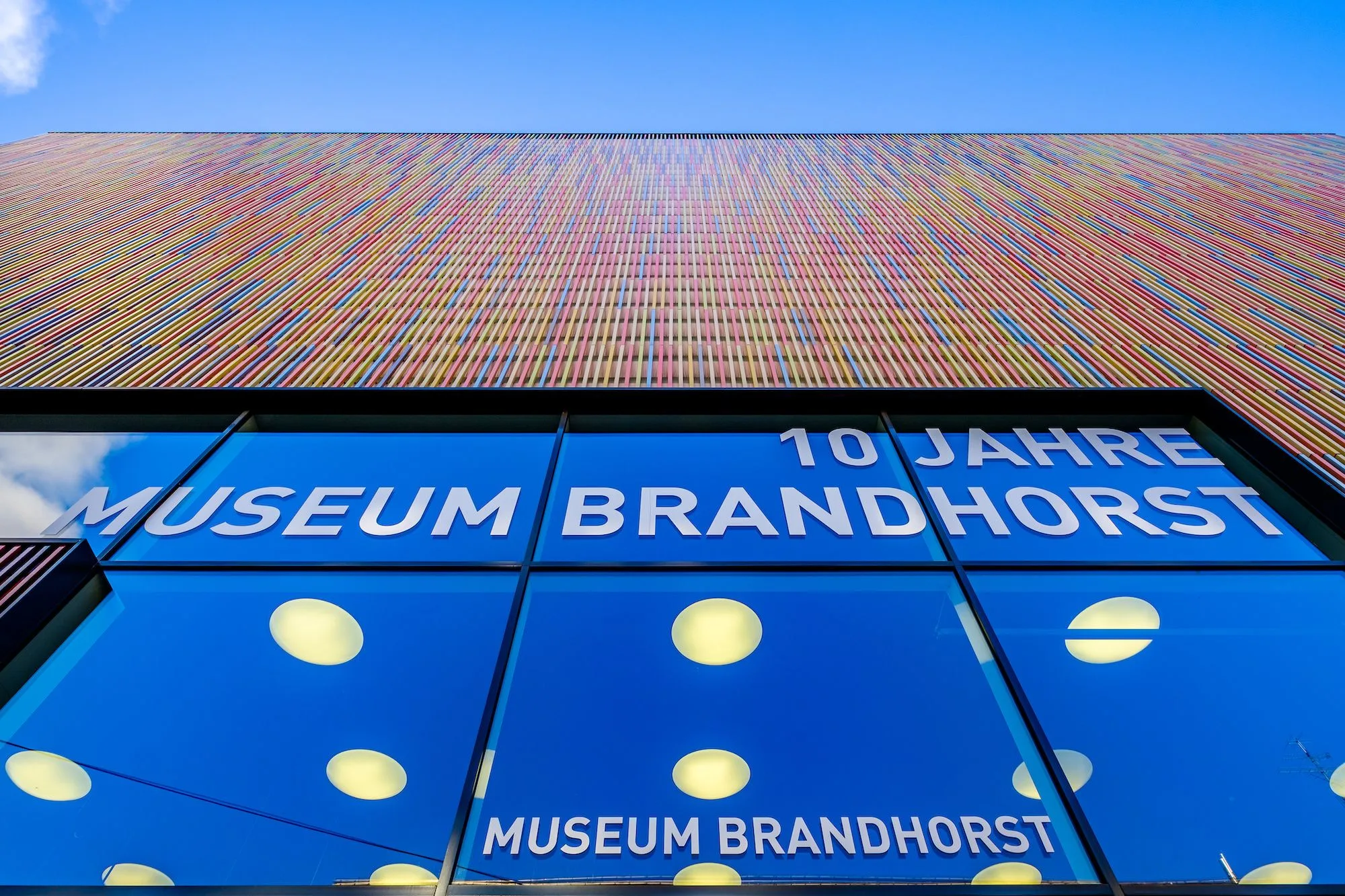
Museum Brandhorst
 Highlight of Arts District
Highlight of Arts DistrictPeruse modern art in this remarkably different building.
The Museum Brandhorst is an eye-catching structure covered with 36,000 polychromatic ceramic rods in 23 custom colors and a second layer consisting of a horizontally folded metal skin, coated in two colors. This layering and its polychromy lend the skin a varied appearance: What is vivid and three-dimensional from close up appears homogeneous and flat from afar. It was opened in 2009 to house a collection of German and modern art in a setting of restrained, spacious modernism. Its rotating exhibits include works by Andy Warhol, Jeff Koons, and Picasso, as well as major contemporary German artists.
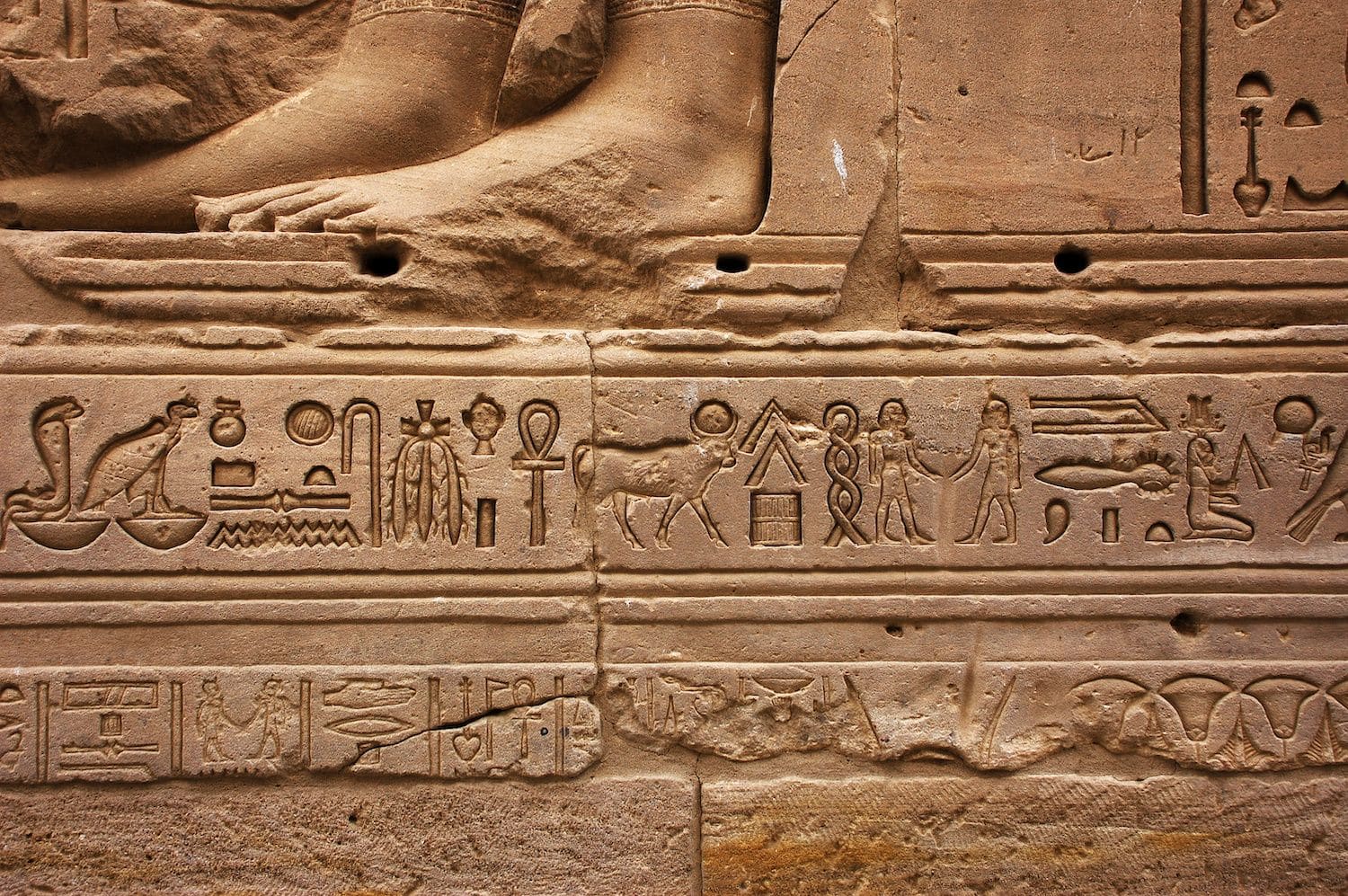
State Museum of Egyptian Art
 Highlight of Arts District
Highlight of Arts DistrictHistory buffs will love this underappreciated museum dedicated to Egyptian archaeology.
The impressive entrance to the brand spanking new State Museum of Egyptian Art is reminiscent of a grand descent into a Pharoah's tomb. Opened in 2013 to house artifacts formerly contained in the Residenz, the museum has a collection which spans 5000 years of Egyptian history.

Alte Pinakothek
 Highlight of Arts District
Highlight of Arts DistrictEnjoy a tremendous collection of art in what was once the world's largest art gallery.
The largest art gallery in the world when it was first opened in 1836, the Alte Pinakothek can still be an overwhelming experience: the collections, which are based on the royal collection of the Wittelsbach dynasty over five hundred years, are arranged geographically and chronologically, encompassing German, Dutch, Flemish, Spanish, French and Italian art, with a timespan from the Middle Ages to the 18th century. It houses the largest collection of Rubens in the world, so be sure to stop by the Flemish paintings. Also worthy of particular attention if you're short on time are the richly comic works by Pieter Brueghel in the Netherlandish collection, and the German late Gothic and Renaissance art collection represented by the likes of Albrecht Dürer and Cranach the Elder.
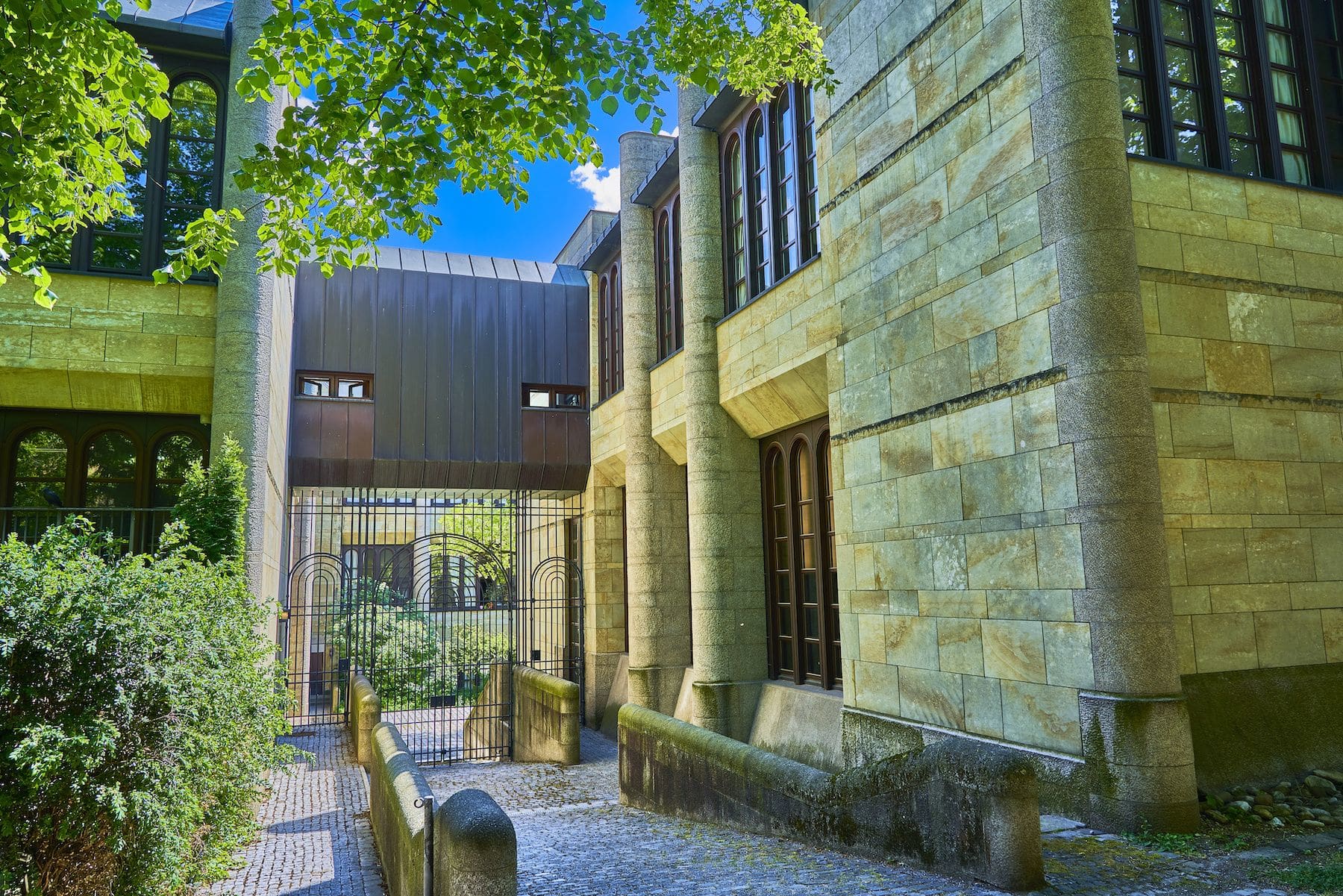
Neue Pinakothek
 Highlight of Arts District
Highlight of Arts DistrictSee some of the 19th and early 20th centuries' greatest artworks.
Directly across the road from Alte Pinakothek, the Neue Pinakothek picks up where the older museum leaves off, concentrating on art from the 19th century to Jugendstil. The audio-guide tour starts with art from around 1800, prominent among which are a number of canvases by Goya, before progressing to English painting from the likes of Gainsborough, Constable, and Turner. Much of the rest of the museum is given over to German Art, with an emphasis on artists active in the court of Ludwig I, such as work by the architect who designed the Alte Pinakothek, Leo von Klenze, and the Berlin architect Karl Friedrich Schinkel. There are also works by Caspar David Friedrich and Adolph von Menzel.

Pinakothek der Moderne
 Highlight of Arts District
Highlight of Arts DistrictPeruse 19th and 20th century art in a stylishly modern setting.
The strikingly clean-lined Pinakothek der Moderne, gathers its eclectic collection of classic modern and contemporary art, design and architecture around a central rotunda. On the west side of the building are works representing last century's key artistic movements, from Cubism through to Surrealism and beyond. The east wing is devoted to contemporary art.

Museum Brandhorst
 Highlight of Arts District
Highlight of Arts DistrictPeruse modern art in this remarkably different building.
The Museum Brandhorst is an eye-catching structure covered with 36,000 polychromatic ceramic rods in 23 custom colors and a second layer consisting of a horizontally folded metal skin, coated in two colors. This layering and its polychromy lend the skin a varied appearance: What is vivid and three-dimensional from close up appears homogeneous and flat from afar. It was opened in 2009 to house a collection of German and modern art in a setting of restrained, spacious modernism. Its rotating exhibits include works by Andy Warhol, Jeff Koons, and Picasso, as well as major contemporary German artists.

State Museum of Egyptian Art
 Highlight of Arts District
Highlight of Arts DistrictHistory buffs will love this underappreciated museum dedicated to Egyptian archaeology.
The impressive entrance to the brand spanking new State Museum of Egyptian Art is reminiscent of a grand descent into a Pharoah's tomb. Opened in 2013 to house artifacts formerly contained in the Residenz, the museum has a collection which spans 5000 years of Egyptian history.

Alte Pinakothek
 Highlight of Arts District
Highlight of Arts DistrictEnjoy a tremendous collection of art in what was once the world's largest art gallery.
The largest art gallery in the world when it was first opened in 1836, the Alte Pinakothek can still be an overwhelming experience: the collections, which are based on the royal collection of the Wittelsbach dynasty over five hundred years, are arranged geographically and chronologically, encompassing German, Dutch, Flemish, Spanish, French and Italian art, with a timespan from the Middle Ages to the 18th century. It houses the largest collection of Rubens in the world, so be sure to stop by the Flemish paintings. Also worthy of particular attention if you're short on time are the richly comic works by Pieter Brueghel in the Netherlandish collection, and the German late Gothic and Renaissance art collection represented by the likes of Albrecht Dürer and Cranach the Elder.

Neue Pinakothek
 Highlight of Arts District
Highlight of Arts DistrictSee some of the 19th and early 20th centuries' greatest artworks.
Directly across the road from Alte Pinakothek, the Neue Pinakothek picks up where the older museum leaves off, concentrating on art from the 19th century to Jugendstil. The audio-guide tour starts with art from around 1800, prominent among which are a number of canvases by Goya, before progressing to English painting from the likes of Gainsborough, Constable, and Turner. Much of the rest of the museum is given over to German Art, with an emphasis on artists active in the court of Ludwig I, such as work by the architect who designed the Alte Pinakothek, Leo von Klenze, and the Berlin architect Karl Friedrich Schinkel. There are also works by Caspar David Friedrich and Adolph von Menzel.

Pinakothek der Moderne
 Highlight of Arts District
Highlight of Arts DistrictPeruse 19th and 20th century art in a stylishly modern setting.
The strikingly clean-lined Pinakothek der Moderne, gathers its eclectic collection of classic modern and contemporary art, design and architecture around a central rotunda. On the west side of the building are works representing last century's key artistic movements, from Cubism through to Surrealism and beyond. The east wing is devoted to contemporary art.
prev
next


Day 5
Prague
View More
Day 5
Prague



9:00 AM - 12:30 PM
Prague Castle & Royal Route Guided Walk
On this charming guided walk, you will explore the Prague Castle, the largest castle complex in all of Europe. To reach the castle you will trace the Royal Coronation Route and cross the Charles Bridge, whose “speaking stones” reveal the amazing and often cruel history that occurred there. Your tour guide will then take you either through the castle courtyards and into the dramatic St. Vitus Cathedral in the center of the castle complex, or through the upper part of the castle district around the oversized palaces of the old Catholic nobility and the top of the Castle Steps for incomparable views over the red rooftops of the Little Quarter.

Charles Bridge
Cross the river dividing Prague's most historic neighborhoods, and experience one of Europe's most iconic landmarks.
Show More

Maltese Square & Lennon Wall
See a historic wall that has been covered in John Lennon-inspired graffiti since Communist days.
Show More

Prague Castle
Prague Castle is one of the main attractions in Prague and is also the largest castle complex in the world.
Show More

Charles Bridge
Cross the river dividing Prague's most historic neighborhoods, and experience one of Europe's most iconic landmarks.
Show More

Maltese Square & Lennon Wall
See a historic wall that has been covered in John Lennon-inspired graffiti since Communist days.
Show More

Prague Castle
Prague Castle is one of the main attractions in Prague and is also the largest castle complex in the world.
Show More

Charles Bridge
Cross the river dividing Prague's most historic neighborhoods, and experience one of Europe's most iconic landmarks.
Show More
prev
next

Day 5
Prague
View More

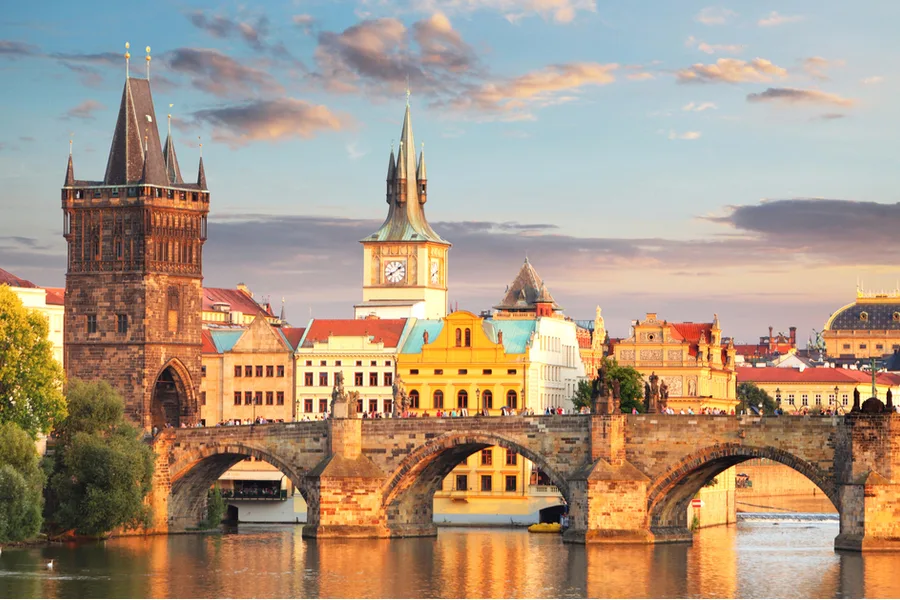
Charles Bridge
 Highlight of Royal Route Guided Tour
Highlight of Royal Route Guided TourCross the river dividing Prague's most historic neighborhoods, and experience one of Europe's most iconic landmarks.
Bridge construction began in 1357 under King Charles IV (hence the name), and it was the only bridge across the Vltava River until 1841. 30 baroque statues of saints line the bridge, and it is filled with street artists and entertainers. Not to be missed.

Maltese Square & Lennon Wall
 Highlight of Royal Route Guided Tour
Highlight of Royal Route Guided TourSee a historic wall that has been covered in John Lennon-inspired graffiti since Communist days.
The wall has been covered in graffiti since the 1960s, and during Communism anti-regime sentiment was common. John Lennon's assassination inspired grafitti reflecting his song, Imagine, which earned the wall its current moniker. It is now a favorite gathering place for tourists, and musicians sometimes congregate there as well. Just around the corner is the Maltese Square, which is one of Prague's more quaint and relaxed public spaces, despite being just off the main tourist route.

Prague Castle
 Highlight of Royal Route Guided Tour
Highlight of Royal Route Guided TourPrague Castle is one of the main attractions in Prague and is also the largest castle complex in the world.
The Prague Castle is the largest castle complex in the world with structures dating back to the 9th century. The St Vitus Cathedral and Basilica of St George can be found within the castle walls. The Prague Castle also includes several gardens, palaces, and a monastery. This castle was the seat of power for the Kings of Bohemia, Holy Roman Emperors, and presidents of former Czechoslovakia. Prague Castle is a UNESCO world heritage site and is one of the most visited places in the country.

Charles Bridge
 Highlight of Royal Route Guided Tour
Highlight of Royal Route Guided TourCross the river dividing Prague's most historic neighborhoods, and experience one of Europe's most iconic landmarks.
Bridge construction began in 1357 under King Charles IV (hence the name), and it was the only bridge across the Vltava River until 1841. 30 baroque statues of saints line the bridge, and it is filled with street artists and entertainers. Not to be missed.

Maltese Square & Lennon Wall
 Highlight of Royal Route Guided Tour
Highlight of Royal Route Guided TourSee a historic wall that has been covered in John Lennon-inspired graffiti since Communist days.
The wall has been covered in graffiti since the 1960s, and during Communism anti-regime sentiment was common. John Lennon's assassination inspired grafitti reflecting his song, Imagine, which earned the wall its current moniker. It is now a favorite gathering place for tourists, and musicians sometimes congregate there as well. Just around the corner is the Maltese Square, which is one of Prague's more quaint and relaxed public spaces, despite being just off the main tourist route.

Prague Castle
 Highlight of Royal Route Guided Tour
Highlight of Royal Route Guided TourPrague Castle is one of the main attractions in Prague and is also the largest castle complex in the world.
The Prague Castle is the largest castle complex in the world with structures dating back to the 9th century. The St Vitus Cathedral and Basilica of St George can be found within the castle walls. The Prague Castle also includes several gardens, palaces, and a monastery. This castle was the seat of power for the Kings of Bohemia, Holy Roman Emperors, and presidents of former Czechoslovakia. Prague Castle is a UNESCO world heritage site and is one of the most visited places in the country.

Charles Bridge
 Highlight of Royal Route Guided Tour
Highlight of Royal Route Guided TourCross the river dividing Prague's most historic neighborhoods, and experience one of Europe's most iconic landmarks.
Bridge construction began in 1357 under King Charles IV (hence the name), and it was the only bridge across the Vltava River until 1841. 30 baroque statues of saints line the bridge, and it is filled with street artists and entertainers. Not to be missed.
prev
next

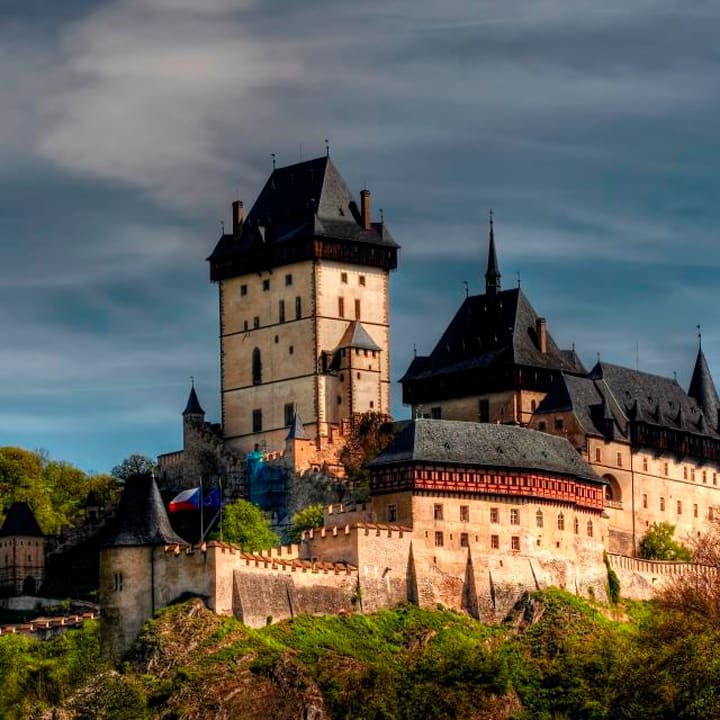
Day 6
Prague
View More
Day 6
Prague



Morning to Afternoon
Excursion by Train to Karlštejn Castle
Karlštejn, i.e. Charles' Stone Castle, is the most famous castle in the Czech Republic. The fairy-tale perfect castle was founded by King Charles IV in 1348 to guard his royal treasures. It's massive towers and walls are spread out over a series of rocky peaks above the Berounka River and commands striking views of the surrounding hills.

Chapel of the Holy Rood
Tour a closely-guarded and jewel-encrusted chapel decorated with amazing medieval art.
Show More

Chapel of the Holy Rood
Tour a closely-guarded and jewel-encrusted chapel decorated with amazing medieval art.
Show More

Chapel of the Holy Rood
Tour a closely-guarded and jewel-encrusted chapel decorated with amazing medieval art.
Show More

Chapel of the Holy Rood
Tour a closely-guarded and jewel-encrusted chapel decorated with amazing medieval art.
Show More

Chapel of the Holy Rood
Tour a closely-guarded and jewel-encrusted chapel decorated with amazing medieval art.
Show More
prev
next

Day 6
Prague
View More

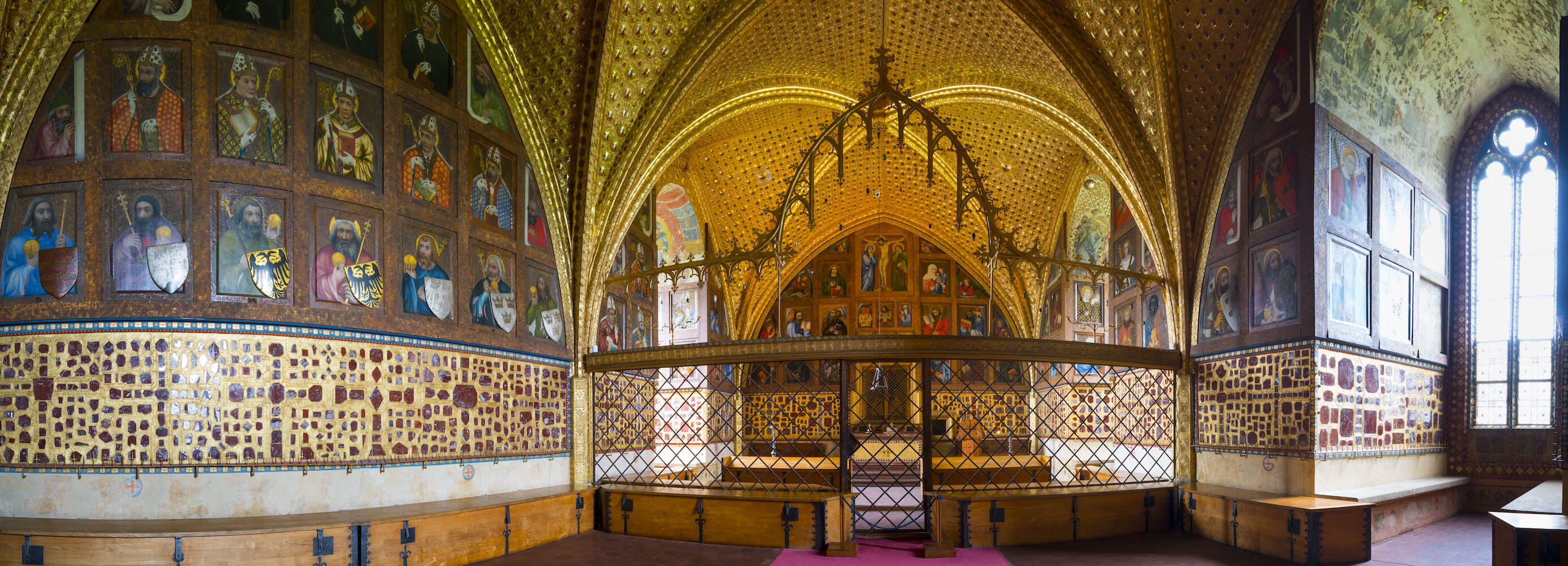
Chapel of the Holy Rood
 Highlight of Karlštejn Castle
Highlight of Karlštejn CastleTour a closely-guarded and jewel-encrusted chapel decorated with amazing medieval art.
The most important and impressive part of the castle, the Chapel of the Holy Rood, is open only to special guided tours due to the fact that its walls are literally covered in precious jewels.

Chapel of the Holy Rood
 Highlight of Karlštejn Castle
Highlight of Karlštejn CastleTour a closely-guarded and jewel-encrusted chapel decorated with amazing medieval art.
The most important and impressive part of the castle, the Chapel of the Holy Rood, is open only to special guided tours due to the fact that its walls are literally covered in precious jewels.

Chapel of the Holy Rood
 Highlight of Karlštejn Castle
Highlight of Karlštejn CastleTour a closely-guarded and jewel-encrusted chapel decorated with amazing medieval art.
The most important and impressive part of the castle, the Chapel of the Holy Rood, is open only to special guided tours due to the fact that its walls are literally covered in precious jewels.

Chapel of the Holy Rood
 Highlight of Karlštejn Castle
Highlight of Karlštejn CastleTour a closely-guarded and jewel-encrusted chapel decorated with amazing medieval art.
The most important and impressive part of the castle, the Chapel of the Holy Rood, is open only to special guided tours due to the fact that its walls are literally covered in precious jewels.

Chapel of the Holy Rood
 Highlight of Karlštejn Castle
Highlight of Karlštejn CastleTour a closely-guarded and jewel-encrusted chapel decorated with amazing medieval art.
The most important and impressive part of the castle, the Chapel of the Holy Rood, is open only to special guided tours due to the fact that its walls are literally covered in precious jewels.
prev
next

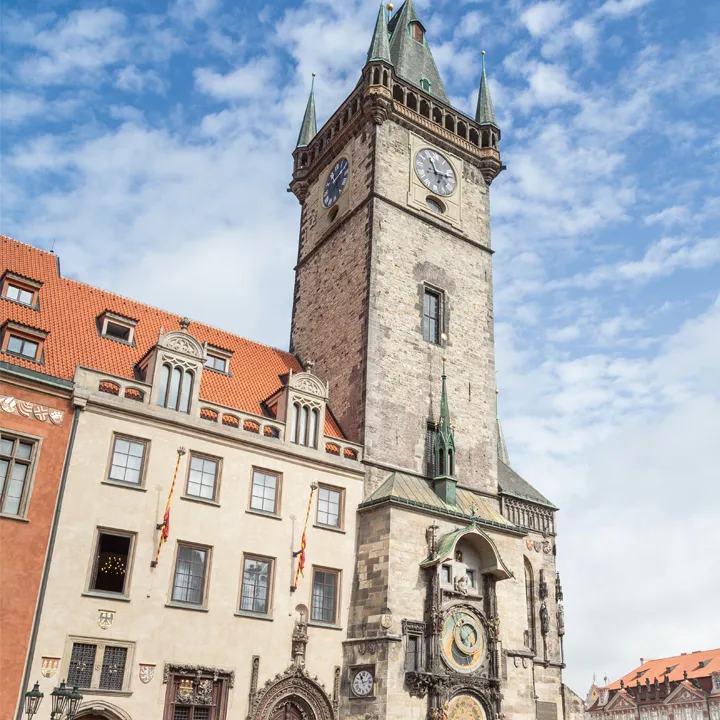
Day 7
Prague
View More
Day 7
Prague



Morning/Mid-Day
Wanderings in the Old Town
A visit to the Old Town transports you to an entirely different era. A labyrinth of twisting cobblestone lanes and alleys surrounds Old Town Square, which has been Prague's municipal center since the Middle Ages. The square is lined by magnificent churches and imposing Renaissance palaces. As you wander through the Old Town, you discover numerous other delights, including several beautiful churches, a plentiful supply of cozy cafes and pubs, and an outdoor market dating back to the Middle Ages.

Church of Our Lady before Týn
Count the spires on the Church of Our Lady Týn before discovering the hidden courtyard behind it.
Show More

Clementinum
Discover a large historical complex of buildings and courtyards "hidden in plain sight" within the Old Town.
Show More

Old Town Square
Make sure to visit one of Europe's most important, historic, and stunning city squares.
Show More

Old Town Hall and Astronomical Clock
See Prague's most photographed moment when the late medieval timepiece constructed on the side of the Old Town Hall Tower comes to life at the top of the hour.
Show More

Church of Our Lady before Týn
Count the spires on the Church of Our Lady Týn before discovering the hidden courtyard behind it.
Show More

Clementinum
Discover a large historical complex of buildings and courtyards "hidden in plain sight" within the Old Town.
Show More

Old Town Square
Make sure to visit one of Europe's most important, historic, and stunning city squares.
Show More

Old Town Hall and Astronomical Clock
See Prague's most photographed moment when the late medieval timepiece constructed on the side of the Old Town Hall Tower comes to life at the top of the hour.
Show More
prev
next

Day 7
Prague
View More

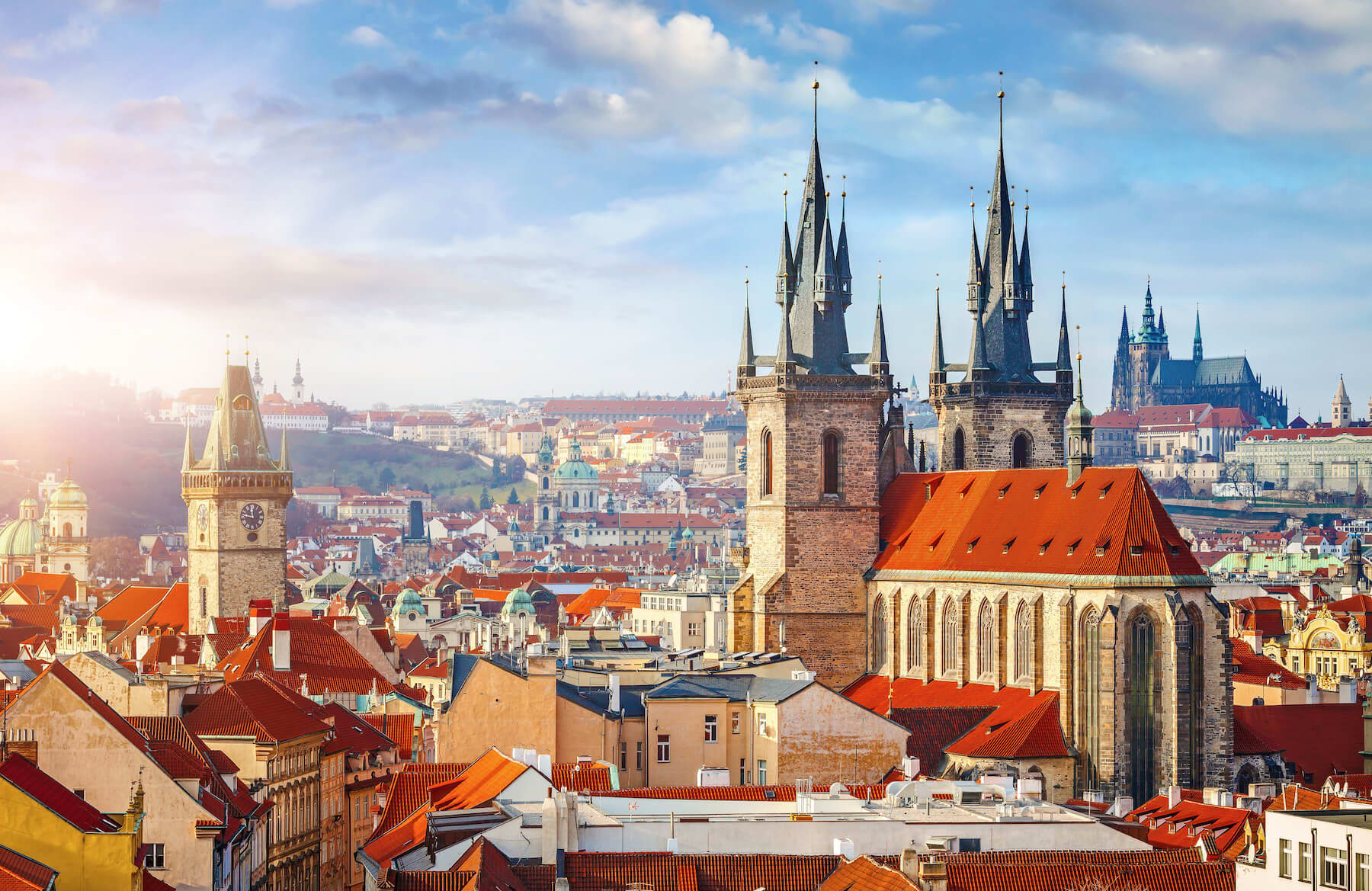
Church of Our Lady before Týn
 Highlight of Old Town
Highlight of Old TownCount the spires on the Church of Our Lady Týn before discovering the hidden courtyard behind it.
The 14th-century, Gothic church is a stunning structure with asymmetrical towers (note that the one on the right is slightly larger than the one on the left). It is the dominant feature of Old Town square and serves as an extensive gallery of Gothic, Renaissance and Early Baroque works. The church is the final resting place for the great astronomer Tycho Brahe.

Clementinum
 Highlight of Old Town
Highlight of Old TownDiscover a large historical complex of buildings and courtyards "hidden in plain sight" within the Old Town.
Founded as an abbey in the 11th century and later transformed into a Jesuit university, it is the second largest complex of buildings in Prague after the castle and contains four separate churches. Guided tours begin at 10am, and include an awe-inspiring Baroque library hall and the Astronomical Tower, from which you have a beautiful view of the Old Town.
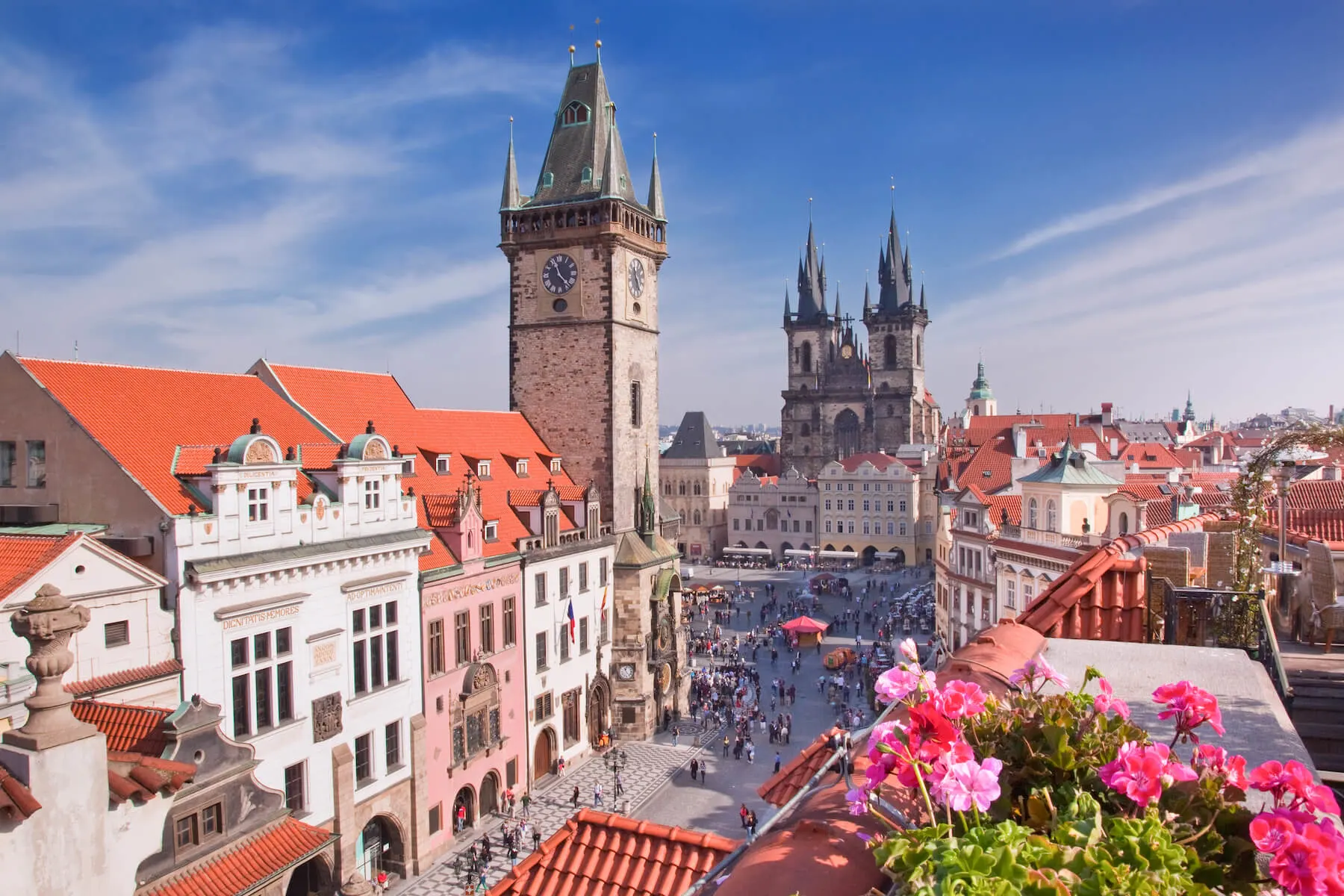
Old Town Square
 Highlight of Old Town
Highlight of Old TownMake sure to visit one of Europe's most important, historic, and stunning city squares.
The square is filled with rich history and surrounded by many beautiful old buildings, such as the gothic church of Our Lady before Týn and the baroque church of St. Nicholas. At the center of the square is a large statue of Jan Hus, a church reformer burnt at the stake in 1415, and a lovely and recently-restored column topped by the Virgin Mary. Today the square is filled with street performers, food stalls, and horse-drawn carriages.

Old Town Hall and Astronomical Clock
 Highlight of Old Town
Highlight of Old TownSee Prague's most photographed moment when the late medieval timepiece constructed on the side of the Old Town Hall Tower comes to life at the top of the hour.
Apostles proceed from the tower’s 1410 astronomical clock hourly, flanked by figures representing vanity, greed, death, and pleasure. You can also take an elevator to the top of the Old Town Hall tower for a great view of the Old Town Square and rooftops. Tours of the town hall and its gothic cellars are also offered.

Church of Our Lady before Týn
 Highlight of Old Town
Highlight of Old TownCount the spires on the Church of Our Lady Týn before discovering the hidden courtyard behind it.
The 14th-century, Gothic church is a stunning structure with asymmetrical towers (note that the one on the right is slightly larger than the one on the left). It is the dominant feature of Old Town square and serves as an extensive gallery of Gothic, Renaissance and Early Baroque works. The church is the final resting place for the great astronomer Tycho Brahe.

Clementinum
 Highlight of Old Town
Highlight of Old TownDiscover a large historical complex of buildings and courtyards "hidden in plain sight" within the Old Town.
Founded as an abbey in the 11th century and later transformed into a Jesuit university, it is the second largest complex of buildings in Prague after the castle and contains four separate churches. Guided tours begin at 10am, and include an awe-inspiring Baroque library hall and the Astronomical Tower, from which you have a beautiful view of the Old Town.

Old Town Square
 Highlight of Old Town
Highlight of Old TownMake sure to visit one of Europe's most important, historic, and stunning city squares.
The square is filled with rich history and surrounded by many beautiful old buildings, such as the gothic church of Our Lady before Týn and the baroque church of St. Nicholas. At the center of the square is a large statue of Jan Hus, a church reformer burnt at the stake in 1415, and a lovely and recently-restored column topped by the Virgin Mary. Today the square is filled with street performers, food stalls, and horse-drawn carriages.

Old Town Hall and Astronomical Clock
 Highlight of Old Town
Highlight of Old TownSee Prague's most photographed moment when the late medieval timepiece constructed on the side of the Old Town Hall Tower comes to life at the top of the hour.
Apostles proceed from the tower’s 1410 astronomical clock hourly, flanked by figures representing vanity, greed, death, and pleasure. You can also take an elevator to the top of the Old Town Hall tower for a great view of the Old Town Square and rooftops. Tours of the town hall and its gothic cellars are also offered.
prev
next


Day 8
Depart Prague
View More
Day 8
Depart Prague

To Be Determined
Transfer to Airport by Taxi

Day 8
Depart Prague
View More


What's Included In Your Trip

Pre-Paid Tours and Activities:
- Guided Walk Tour of Historic Munich
- Prague Castle & Royal Route Guided Walk
- City Card for Munich, including discounts to many popular attractions

Pre-Paid Transportation:
- 2nd Class Train Tickets from Munich to Prague
- Public Transport Tickets for Munich

Accommodation:
- 4 nights at a hotel of your choice in Munich
- 5 nights at a hotel of your choice in Prague

Go Real Travel Mobile App:
- Itinerary Plan & Reservations Info
- Points of Interest
- Detailed Travel Information
- Maps & Directions
Other Trips You May Like

11 Days
From$2098USD
Palaces, Culture & Capitals: Munich to Budapest Epic

Germany, Czech Republic, Austria, Hungary

21 Days
From$5199USD
Central European Journey through Switzerland, Germany, Austria and the Czech Republic

Switzerland, Germany, Austria, Czech Republic

5 Days
From$700USD

4 Days
From$799USD

10 Days
From$1695USD
10 Day Munich and Prague Tour: Castles, Culture, and Beer Tasting Adventures

Germany, Czech Republic

10 Days
From$3250USD
Enchanting Christmas Market Trip to Bavaria & Prague with Gabriella-Maria

Germany, Czech Republic

8 Days
From$1729USD

14 Days
From$2897USD
14-Day Trip to Historic Munich, Salzburg, Vienna, and Prague

Germany, Austria, Czech Republic

12 Days
From$2449USD
12 Days in the Heart of Central Europe: Berlin, Prague, Vienna, and Munich

Germany, Czech Republic, Austria

11 Days
From$2098USD
Palaces, Culture & Capitals: Munich to Budapest Epic

Germany, Czech Republic, Austria, Hungary

21 Days
From$5199USD
Central European Journey through Switzerland, Germany, Austria and the Czech Republic

Switzerland, Germany, Austria, Czech Republic

5 Days
From$700USD

4 Days
From$799USD

10 Days
From$1695USD
10 Day Munich and Prague Tour: Castles, Culture, and Beer Tasting Adventures

Germany, Czech Republic

10 Days
From$3250USD
Enchanting Christmas Market Trip to Bavaria & Prague with Gabriella-Maria

Germany, Czech Republic

8 Days
From$1729USD

14 Days
From$2897USD
14-Day Trip to Historic Munich, Salzburg, Vienna, and Prague

Germany, Austria, Czech Republic

12 Days
From$2449USD
12 Days in the Heart of Central Europe: Berlin, Prague, Vienna, and Munich

Germany, Czech Republic, Austria
prev
next
Featured Blogs
prev
next
Our Customers Say It Best
Otto Chuy, Los Angeles, California
I am still surprised how everything worked as planned, without a hitch. All instructions in your itinerary were precise and correct. Your suggestions and comments in each of the locations we went to were very helpful. All your guides, without exception, were wonderful and exactly on time. 

Kathy Mongeau, Ottawa, Ontario
My sister, Ann Ibberson, and I have been back home for a few weeks now and still go on and on about our fabulous trip. We were just blown away in every respect. Given the fact that we only had 1 ½ weeks, you had everything arranged for us so efficiently and your contacts who we dealt with for transfers, tours, hotels were extremely professional and personable. Things could not have gone better. 

Clive Andrew, Brisbane, Queensland
Just a quick note to let you know that I am back home now after probably the best overseas holiday that I have ever had, in no small part due to your very capable organization booking of hotels, tours, & trains. There was just nothing that went wrong with the timings etc. 

Malini Dutta, Boston, Massachusetts
We can't thank you enough for the detailed plans, maps, and suggestions. It really felt that someone was holding our hands and showing us around. We had all the excitement of discovering foreign lands, with none of the problems that can happen while negotiating unfamiliar places. In fact, all the cities felt like home within a few hours of arriving and exploring. 

Bev and Mark Frankel, Williamsburg, Virginia
We could not be more pleased with Go Real Travel! You took the guess work out of things like public transport but still managed to allow us the freedom to tour as we wanted. Our guides were exceptional and every time I saw a Viking Cruise tour of 25 people, I realized the quality experience we were getting with Go Real. 

Marianne Strydom, Paarl, South Africa
I just wanted to thank you for organizing an amazing trip for me – I packed in so much in such a short period of time and everything was just perfect. The way you do things makes it possible to really get to know the destination, which for me as a travel agent could not have been better. 

Otto Chuy, Los Angeles, California
I am still surprised how everything worked as planned, without a hitch. All instructions in your itinerary were precise and correct. Your suggestions and comments in each of the locations we went to were very helpful. All your guides, without exception, were wonderful and exactly on time. 

Kathy Mongeau, Ottawa, Ontario
My sister, Ann Ibberson, and I have been back home for a few weeks now and still go on and on about our fabulous trip. We were just blown away in every respect. Given the fact that we only had 1 ½ weeks, you had everything arranged for us so efficiently and your contacts who we dealt with for transfers, tours, hotels were extremely professional and personable. Things could not have gone better. 

Clive Andrew, Brisbane, Queensland
Just a quick note to let you know that I am back home now after probably the best overseas holiday that I have ever had, in no small part due to your very capable organization booking of hotels, tours, & trains. There was just nothing that went wrong with the timings etc. 

Malini Dutta, Boston, Massachusetts
We can't thank you enough for the detailed plans, maps, and suggestions. It really felt that someone was holding our hands and showing us around. We had all the excitement of discovering foreign lands, with none of the problems that can happen while negotiating unfamiliar places. In fact, all the cities felt like home within a few hours of arriving and exploring. 

Bev and Mark Frankel, Williamsburg, Virginia
We could not be more pleased with Go Real Travel! You took the guess work out of things like public transport but still managed to allow us the freedom to tour as we wanted. Our guides were exceptional and every time I saw a Viking Cruise tour of 25 people, I realized the quality experience we were getting with Go Real. 

Marianne Strydom, Paarl, South Africa
I just wanted to thank you for organizing an amazing trip for me – I packed in so much in such a short period of time and everything was just perfect. The way you do things makes it possible to really get to know the destination, which for me as a travel agent could not have been better. 



Explore cities in more detail
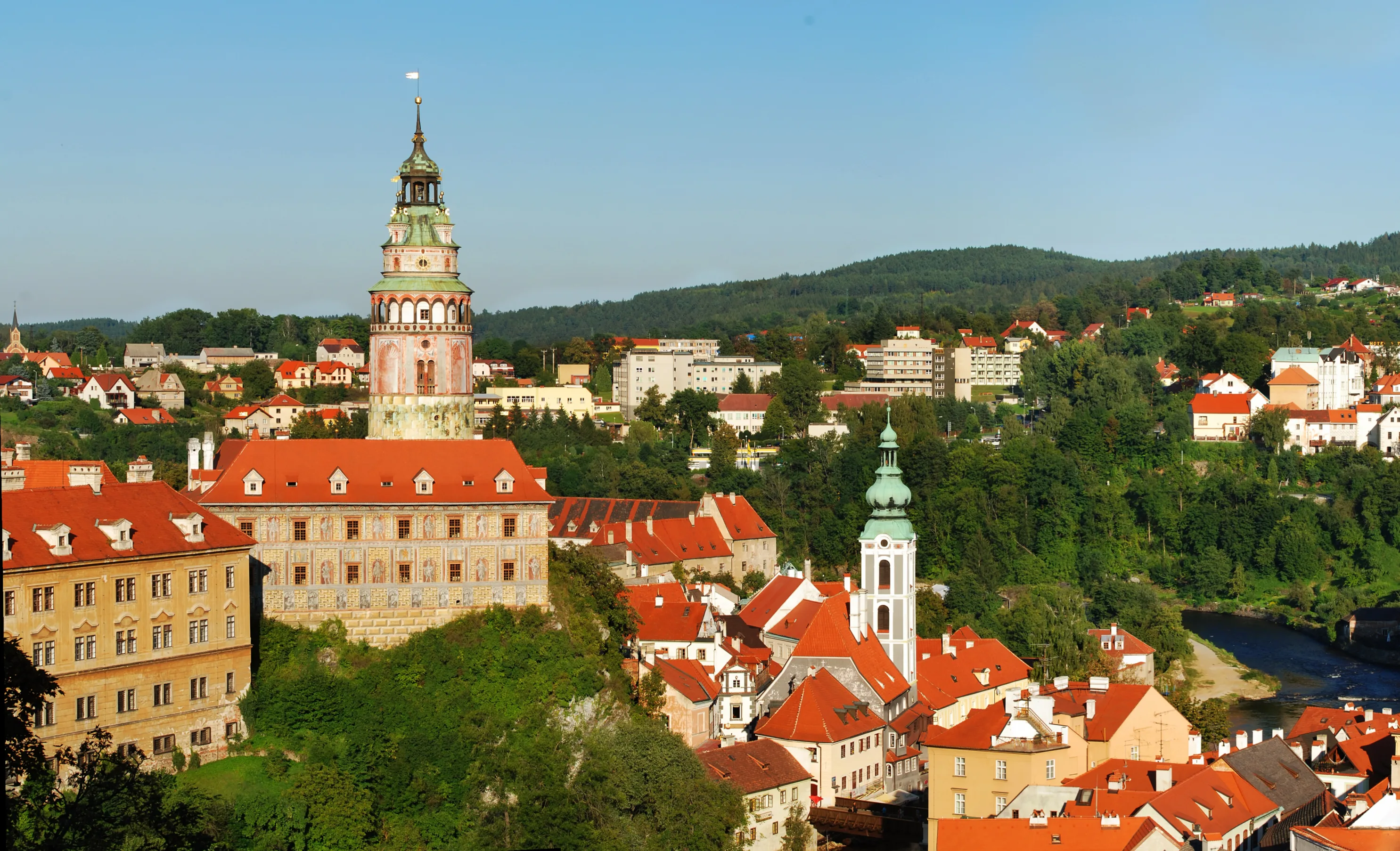
Cesky Krumlov
Cesky Krumlov is a charming little town in South Bohemia. It might be small, but it’s full of whimsical character and mystery. Walking through the narrow streets and across the bridge, the views of the medieval Cesky Krumlov Castle will take your breath away. At night, street musicians serenade visitors on the bridge where you can dance beneath the stars and the watchful eye of the magnificent tower. Dozens of unique local artisan shops, cafes, and restaurants are woven among the winding streets. In the summer, the city is lush with life and greenery. Rafters race down the river, stopping in the center along the way to enjoy a hearty meal before continuing their journey. In the winter, the main square transforms into a magnificent Christmas market and light blankets of snow cover the rooftops. This quaint little town will exceed your expectations and you may never want to leave.
Read More
Learn About Cesky Krumlov
Build Cesky Krumlov Trip

Nuremberg
One of the most authentic, storied German destinations, Nuremberg's picturesque old town, glorious castle, and buzzing Christmas Market makes this city a time-true classic. The ideal gateway to old Bavaria, Nuremberg offers a primer in German history before you embark on the lovely journey through old Bavaria, known as the Romantic Road. Considered the capital of the Holy Roman Empire in the middle ages, Nuremberg would have felt like the center of the world as a procession of kings and emperors passed through its magnificent gates. When the German Renaissance came, Nuremberg was at its heart. Albrecht Dürer, the great German master artist, was born here, and Martin Luther called Nuremberg Germany's 'eyes and ears'. Skip forward a few centuries, and the city took a dark turn, as Nuremberg became a gathering point for the German National Socialists. Slightly outside of town, you can still find the Nazi Party Rallying Grounds, a sobering reminder of the not so distant past. If it all gets too heavy, you can end the day with a glass of rotbier (red beer) and mull it over. Nuremberg is a must-see for anyone who wants to delve into Germany's past.
Read More
Learn About Nuremberg
Build Nuremberg Trip

Frankfurt
Dubbed ‘Mainhatten’ for its glass highrises, financial prowess, and proximity to the Main River, Frankfurt offers a fascinating glimpse into the ‘engine room’ of Europe’s economy with an unexpected twist. Among the glass and steel buildings, the old-worldly Römerberg square will give you a double-take. The square’s 15th-century half-timbered houses, old statues, and church spires contrast dramatically against the modern 21st-century skyscrapers beyond. If you visit at Christmas, the Römerberg is truly special, aglow with the light of the tallest Christmas tree in Germany. The square fills with stalls selling handicrafts, and the air is scented with hot apple wine, honey, and cinnamon. Delve deeper into Frankfurt and you’ll find a substantial museum district, the Museumsufer (Museum Embankment). This area features a cluster of twelve museums on either side of Main River. This includes the Städel, home to Tischbein’s famous painting of renowned writer Johann Wolfgang von Goethe, one of Frankfurt’s most prestigious sons. The more time you spend in Frankfurt, the more you’ll discover a highly cultured city lurking beneath its glass facades. If you have the time, Frankfurt is certainly worth a second look.
Read More
Learn About Frankfurt
Build Frankfurt Trip
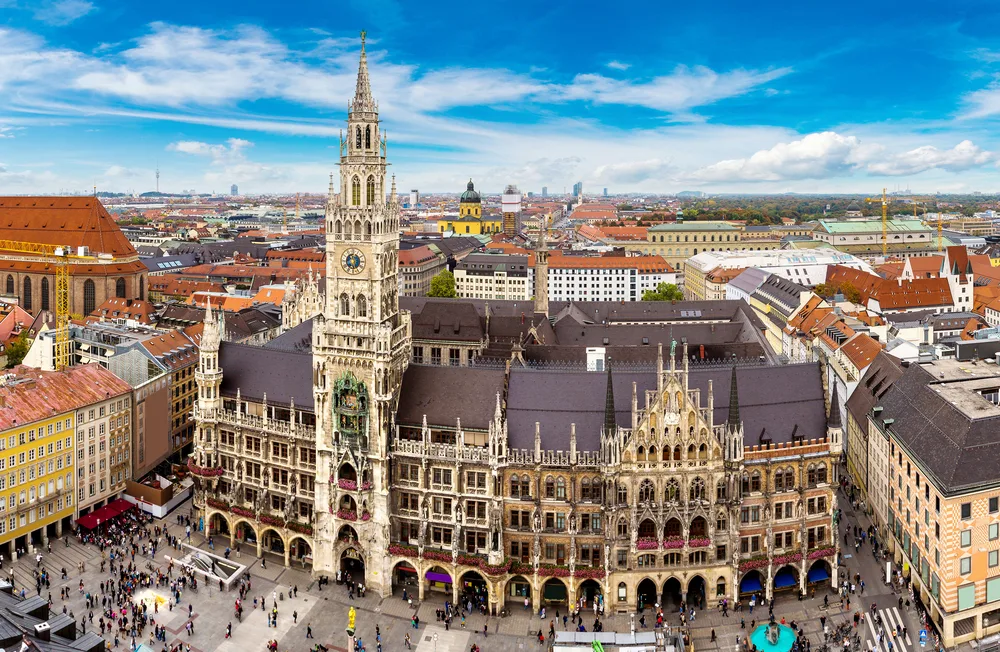
Munich
Arriving in Munich, you would be forgiven for thinking you were on the set of a movie about old Bavaria. At the Old Town beer halls, barmaids laced in dirndl dresses serve up frosty Helles lager, as oom-pah music drifts across the Marienplatz square. Men in lederhosen and checked shirts merrily give toasts as they knock glasses, or steins, as they’re known here. They sit at tables laden with wurst sausage and giant pretzels oozing with herby butter. This is Germany’s Germany, a place where folk traditions never stopped, and the revelry doesn’t either. Even when it isn’t Oktoberfest, the town’s notorious beer-drinking celebration, Munich is always happy to show you a good time. Simply cast your eyes around the lavish, gilded banquet hall at the Munich Residenz, the 13th-century Wittelsbach palace. You’ll see Munich has been impressing guests for centuries. Or, swing by the BMW Museum and check out the classic German cars. They even let you sit inside to test out the new models. At the city’s English Gardens, surfers ride waves on one of the park’s rivers. Munich is filled to the brim with this kind of pure-hearted German fun.
Read More
Learn About Munich
Build Munich Trip

Prague
The city of Prague is indisputably the gem of Central Europe. Full of history, culture, and classic Czech pubs around every corner, Prague is teeming with nooks and crannies just waiting to be discovered. The narrow cobblestone streets and warm red rooftops give the city a homey feel, while the well-preserved medieval architecture transports you back in time. Walking across the Charles Bridge with the view of the Prague Castle will make you feel like you’re living in a fairytale, and you might as well be. As an up-and-coming destination, Prague is a perfect mix of classic and modern. New trendy cafes and bistros are always popping up, and you can always find a group of lively locals chowing down on goulash and quaffing pivo (the best beer in Europe!) at traditional Czech restaurants across the city. The clash of modernity and tradition, preservation and innovation, gives this city a mysterious air that you won’t soon forget.
Read More
Learn About Prague
Build Prague Trip

Salzburg
You've probably heard this before— the city of Salzburg is straight out of a fairytale. Nestled in the mountains, this romantic city's Baroque architecture with colorful domes and spires is especially striking against the ancient fortress and Austrian Alpine backdrop. If you're looking for an amazing view, climb up to Hohensalzburg Fortress, Central Europe's largest intact fortress, for a jaw-dropping panorama of the city backed by misty mountains. Perhaps most famous for being the birthplace of the renowned composer Wolfgang Amadeus Mozart and the filming location for the classic The Sound of Music, this city has much to offer. Salzburg has become an important artistic and cultural center, featuring magnificent concert halls that uphold the city's tradition of classical music every day of the year, as well as acclaimed art exhibitions and museums. If you do it right, your visit to Salzburg will immerse you in the city's unforgettable atmosphere and keep you coming back for more.
Read More
Learn About Salzburg
Build Salzburg Trip

Cesky Krumlov
Cesky Krumlov is a charming little town in South Bohemia. It might be small, but it’s full of whimsical character and mystery. Walking through the narrow streets and across the bridge, the views of the medieval Cesky Krumlov Castle will take your breath away. At night, street musicians serenade visitors on the bridge where you can dance beneath the stars and the watchful eye of the magnificent tower. Dozens of unique local artisan shops, cafes, and restaurants are woven among the winding streets. In the summer, the city is lush with life and greenery. Rafters race down the river, stopping in the center along the way to enjoy a hearty meal before continuing their journey. In the winter, the main square transforms into a magnificent Christmas market and light blankets of snow cover the rooftops. This quaint little town will exceed your expectations and you may never want to leave.
Read More
Learn About Cesky Krumlov
Build Cesky Krumlov Trip

Nuremberg
One of the most authentic, storied German destinations, Nuremberg's picturesque old town, glorious castle, and buzzing Christmas Market makes this city a time-true classic. The ideal gateway to old Bavaria, Nuremberg offers a primer in German history before you embark on the lovely journey through old Bavaria, known as the Romantic Road. Considered the capital of the Holy Roman Empire in the middle ages, Nuremberg would have felt like the center of the world as a procession of kings and emperors passed through its magnificent gates. When the German Renaissance came, Nuremberg was at its heart. Albrecht Dürer, the great German master artist, was born here, and Martin Luther called Nuremberg Germany's 'eyes and ears'. Skip forward a few centuries, and the city took a dark turn, as Nuremberg became a gathering point for the German National Socialists. Slightly outside of town, you can still find the Nazi Party Rallying Grounds, a sobering reminder of the not so distant past. If it all gets too heavy, you can end the day with a glass of rotbier (red beer) and mull it over. Nuremberg is a must-see for anyone who wants to delve into Germany's past.
Read More
Learn About Nuremberg
Build Nuremberg Trip

Frankfurt
Dubbed ‘Mainhatten’ for its glass highrises, financial prowess, and proximity to the Main River, Frankfurt offers a fascinating glimpse into the ‘engine room’ of Europe’s economy with an unexpected twist. Among the glass and steel buildings, the old-worldly Römerberg square will give you a double-take. The square’s 15th-century half-timbered houses, old statues, and church spires contrast dramatically against the modern 21st-century skyscrapers beyond. If you visit at Christmas, the Römerberg is truly special, aglow with the light of the tallest Christmas tree in Germany. The square fills with stalls selling handicrafts, and the air is scented with hot apple wine, honey, and cinnamon. Delve deeper into Frankfurt and you’ll find a substantial museum district, the Museumsufer (Museum Embankment). This area features a cluster of twelve museums on either side of Main River. This includes the Städel, home to Tischbein’s famous painting of renowned writer Johann Wolfgang von Goethe, one of Frankfurt’s most prestigious sons. The more time you spend in Frankfurt, the more you’ll discover a highly cultured city lurking beneath its glass facades. If you have the time, Frankfurt is certainly worth a second look.
Read More
Learn About Frankfurt
Build Frankfurt Trip

Munich
Arriving in Munich, you would be forgiven for thinking you were on the set of a movie about old Bavaria. At the Old Town beer halls, barmaids laced in dirndl dresses serve up frosty Helles lager, as oom-pah music drifts across the Marienplatz square. Men in lederhosen and checked shirts merrily give toasts as they knock glasses, or steins, as they’re known here. They sit at tables laden with wurst sausage and giant pretzels oozing with herby butter. This is Germany’s Germany, a place where folk traditions never stopped, and the revelry doesn’t either. Even when it isn’t Oktoberfest, the town’s notorious beer-drinking celebration, Munich is always happy to show you a good time. Simply cast your eyes around the lavish, gilded banquet hall at the Munich Residenz, the 13th-century Wittelsbach palace. You’ll see Munich has been impressing guests for centuries. Or, swing by the BMW Museum and check out the classic German cars. They even let you sit inside to test out the new models. At the city’s English Gardens, surfers ride waves on one of the park’s rivers. Munich is filled to the brim with this kind of pure-hearted German fun.
Read More
Learn About Munich
Build Munich Trip

Prague
The city of Prague is indisputably the gem of Central Europe. Full of history, culture, and classic Czech pubs around every corner, Prague is teeming with nooks and crannies just waiting to be discovered. The narrow cobblestone streets and warm red rooftops give the city a homey feel, while the well-preserved medieval architecture transports you back in time. Walking across the Charles Bridge with the view of the Prague Castle will make you feel like you’re living in a fairytale, and you might as well be. As an up-and-coming destination, Prague is a perfect mix of classic and modern. New trendy cafes and bistros are always popping up, and you can always find a group of lively locals chowing down on goulash and quaffing pivo (the best beer in Europe!) at traditional Czech restaurants across the city. The clash of modernity and tradition, preservation and innovation, gives this city a mysterious air that you won’t soon forget.
Read More
Learn About Prague
Build Prague Trip

Salzburg
You've probably heard this before— the city of Salzburg is straight out of a fairytale. Nestled in the mountains, this romantic city's Baroque architecture with colorful domes and spires is especially striking against the ancient fortress and Austrian Alpine backdrop. If you're looking for an amazing view, climb up to Hohensalzburg Fortress, Central Europe's largest intact fortress, for a jaw-dropping panorama of the city backed by misty mountains. Perhaps most famous for being the birthplace of the renowned composer Wolfgang Amadeus Mozart and the filming location for the classic The Sound of Music, this city has much to offer. Salzburg has become an important artistic and cultural center, featuring magnificent concert halls that uphold the city's tradition of classical music every day of the year, as well as acclaimed art exhibitions and museums. If you do it right, your visit to Salzburg will immerse you in the city's unforgettable atmosphere and keep you coming back for more.
Read More
Learn About Salzburg
Build Salzburg Trip
prev
next


 Map of Your Itinerary Route
Map of Your Itinerary Route
Zoom In to the cities to see your itinerary in more detail


 4.8
4.8 







